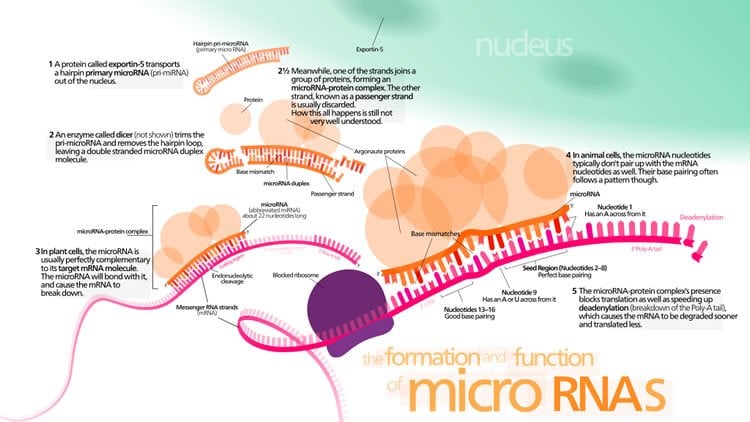Scientists from the Florida campus of The Scripps Research Institute (TSRI) have found that a type of genetic material called “microRNA” plays surprisingly different roles in the formation of memory in animal models. In some cases, these RNAs increase memory, while others decrease it.
“Our systematic screen offers an important first step toward the comprehensive identification of all miRNAs and their potential targets that serve in gene networks important for normal learning and memory,” said Ron Davis, chair of TSRI’s Department of Neuroscience who led the study. “This is a valuable resource for future studies.”
The study was published in the June 2015 edition of the journal Genetics.
Unlike some types of RNA, microRNAs (miRNAs) do not code for proteins but instead regulate various biological processes by modulating the level of gene expression. A number of studies have shown that miRNAs are critical for normal development and cellular growth and may contribute to the complexity of neurodegenerative diseases.
In the new study, 134 different miRNAs were tested for roles in learning and memory in the central nervous system of Drosophila melanogaster, the common fruit fly, which is a recognized animal model for memory studies.
The researchers tested the potential involvement of miRNAs in intermediate-term memory by silencing them individually and identified at least five different miRNAs involved in memory formation or retention.
“Among the five miRNAs identified in this study, we found one that is necessary for memory formation,” said Research Associate Germain U. Busto, a first author of the study with Research Associate Tugba Guven-Ozkan. “Interestingly, its human counterpart is altered in several neurodegenerative diseases, including Alzheimer’s and Huntington’s. It’s possible that this might be a potential model to study and solve some specific aspects of those disorders.”

Surprisingly, the researchers found some miRNAs decreased memory formation, while others increased it. The identified miRNAs affected either neuronal physiology underlying memory formation or the development of the nervous system.
“These microRNAs are highly regulated during brain development and for adult brain function,” said Guven-Ozkan. “When misregulated, they may exacerbate brain diseases like autism, and Alzheimer’s and Huntington’s diseases. We’d like to pinpoint learning and memory pathways to understand how they may lead to human disease.”
In addition to Davis, Busto and Guven-Ozkan, other authors of the study, “microRNAs That Promote or Inhibit Memory Formation in Drosophila melanogaster,” include Tudor A. Fulga and David Van Vactor of Harvard Medical School.
Funding: The work was supported by National Institutes of Health (grants R37 NS19904 and R01 NS069695).
Source: Eric Sauter – Scripps Research Institue
Image Credit: Image is credited to Kelvinsong and islicensed CC by 3.0
Original Research: Abstract for “microRNAs That Promote or Inhibit Memory Formation in Drosophila melanogaster” by Germain U. Busto, Tugba Guven-Ozkan, Tudor A. Fulga, David Van Vactor, and Ronald L. Davis in Genetics. Published online June 2015 doi:10.1534/genetics.114.169623
Abstract
microRNAs That Promote or Inhibit Memory Formation in Drosophila melanogaster
microRNAs (miRNAs) are small noncoding RNAs that regulate gene expression post-transcriptionally. Prior studies have shown that they regulate numerous physiological processes critical for normal development, cellular growth control, and organismal behavior. Here, we systematically surveyed 134 different miRNAs for roles in olfactory learning and memory formation using “sponge” technology to titrate their activity broadly in the Drosophila melanogaster central nervous system. We identified at least five different miRNAs involved in memory formation or retention from this large screen, including miR-9c, miR-31a, miR-305, miR-974, and miR-980. Surprisingly, the titration of some miRNAs increased memory, while the titration of others decreased memory. We performed more detailed experiments on two miRNAs, miR-974 and miR-31a, by mapping their roles to subpopulations of brain neurons and testing the functional involvement in memory of potential mRNA targets through bioinformatics and a RNA interference knockdown approach. This screen offers an important first step toward the comprehensive identification of all miRNAs and their potential targets that serve in gene regulatory networks important for normal learning and memory.
“microRNAs That Promote or Inhibit Memory Formation in Drosophila melanogaster” by Germain U. Busto, Tugba Guven-Ozkan, Tudor A. Fulga, David Van Vactor, and Ronald L. Davis in Genetics. Published online June 2015 doi:10.1534/genetics.114.169623






